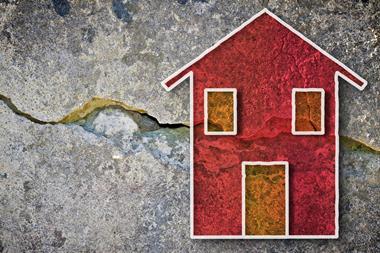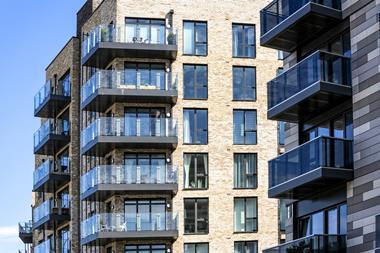’We’ll get shovels in the ground, cranes in the sky and build the next generation of Labour new towns,’ says prime minister
Under the motto “get Britain building again”, the new Labour government has plans to increase housing construction.

As outlined in its 2024 manifesto, entitled Our plan to change Britian, the goal is to build “1.5 million new homes over the next parliament”, a target first announced by prime minister Keir Starmer at the October 2023 party conference.
“We’ll get shovels in the ground, cranes in the sky and build the next generation of Labour new towns,” he declared.
However, Michael Hogg, a London-based partner at the law firm Kennedys, felt this could lead to an “impact [on] property claims” due to an increase in incidents related to construction defects, site conditions and new build warranties.
Brownfield sites
Part of the reason for issues with buildings could come down to an increased use of brownfield sites.
Read: Property insurers facing ‘mixed bag’ of news over claims costs
Read: FCA confirms leasehold buildings insurance reforms
Explore more property-related content here or discover other news analysis stories here
These areas are previously developed lands, often former industrial or commercial properties, that may be contaminated but are now available for redevelopment.
Labour plans to prioritise the development of previously used brownfield land, though it may also consider redesignating green belt as needed.
Harvey Monk, sales director at broker Verlingue, said that the biggest risks associated with new brownfield developments often involve environmental factors, particularly if the sites harbor contaminated land or unknown ground conditions.
“The biggest risks of new brownfield sites would seem to be environmental, should the sites contain contaminated land or unknown ground conditions,” he said.
Monk also noted that these issues can result in property damage claims, as “contaminated land can degrade materials, potentially leading to foundation failures or structural impacts if not properly addressed”.
Contamination can degrade construction materials through processes such as chemical reactions with concrete or metal, leading to corrosion, weakened structural integrity or concrete cracking and crumbling.
Flooding
Meanwhile, Monk also explained that construction on brownfield or greenfield land can expose properties to environmental challenges, including flooding if the land is on or near a flood plain.
And Peter Wassell, director for technical field services at Sedgwick, felt the industry could see an increase in flood claims due to increased construction on brownfield land.
Changing weather patterns can lead to heavier rainfall and surface water flooding, putting additional pressure on aging drainage systems.
According to the ABI data published on 15 April 2024, home insurance claims for weather-related damage totalled £573m for 2023, with flooding accounting for £286m.
Brownfield sites are more prone to flooding due to being located in urban areas with a history of industrial use, where natural water drainage systems have been altered or removed.
These sites often have a high proportion of impermeable surfaces like concrete or asphalt, which prevent water from being absorbed into the ground.
As a result, during heavy rainfall, water cannot naturally soak into the soil, leading to a greater likelihood of surface runoff and flooding.
Wassell explained: “There is a possibility that you might see more general claims if the properties, particularly the brownfield sites, are in inappropriate locations where, for example, they could be more prone to flooding.
“Floods can occur for a variety of reasons. One of the major problems we face now is surface flooding caused by drainage systems that cannot cope with new buildings.
“Many of our drains in the UK, especially the victorian drainage systems, were not designed to handle the number of properties we have today. Therefore, there is a potential for increased flood claims.”
Skills shortage
It is not just environmental issues that could be an issue, however, with Hogg noting that the Labour government’s commitment to increase home building was in an “economic environment where the labour market appears stretched” and skilled contractors were in demand.
Wassell agreed with Hogg’s sentiments, noting that the “the building industry has a significant problem with a labour skills shortage”.
For example, the focusing on the skills construction needs, construction skills network labour market intelligence UK 2024-2028 report, published by the Construction Industry Training Board on 15 May 2024, found that the UK construction industry needs to attract the equivalent of 50,300 extra workers per year to meet expected levels of work over the next five years.
Wassell said: “The Construction Industry Training Board forecasted that the industry needs another quarter of a million tradesmen for construction.
“[This will see] less skilled tradesmen enter the industry [and when this happens it] can lead to defects in the buildings, which can result in claims under the warranty supplied by the builder.”
And Hogg added: “Insurers might need to pay for repairs if defects fall under new home warranty policies.”
Regulation
Monk said that while more exposure to a range of risks could create more insurance claims, the impact could be felt harder due to recent changes to the Defective Premises Act (DPA) 1972 and the introduction of the Building Safety Act 2022 (BSA).
Monk explained that the DPA aims to ensure that buildings, especially homes, meet certain standards, allowing homeowners or tenants to claim compensation if a building is “unfit for habitation”.
Speaking about the BSA, meanwhile, Wassell said: “What the BSA has done is change the limitation period, which is the window in which a claim can be brought against the builder. This period has altered significantly. It is now 15 years, whereas it used to be only seven years.”
Essentially, these moves have expanded the scope for claims in the construction sector, with Hogg noting that new rights of action mean that claims can arise from any construction or refurbishment work, increasing the scope and potential for liability across the industry.
He added: “In my opinion and based on what [Kennedys] has seen, more claims have been referred to us.”
Recovering costs
However, if an insurer has to pay for damages, they can try to recover their costs by pursuing claims against the contractors responsible.
And Hogg noted that insurers can often utilise the DPA as a means to do so, while through the BSA, associated companies can now be pursued through the “corporate veil”.
He said: “Now, the BSA allows claims to be pursued through associated companies, altering the risk profile for many manufacturers and developers by potentially exposing them to greater financial liability.
“If a developer or builder goes bankrupt, the BSA allows claims to be made against their associates through a Building Liability Order (BLO).”
A BLO is a legal document that outlines the responsibilities and obligations of parties involved in a construction project, especially regarding safety and compliance with regulations.
If issues arise, such as defects or accidents, this order helps determine who is liable for the costs and damages, ensuring that the responsible parties are held accountable.
However, Hogg noted that uncertainty remains regarding how courts will determine when it is appropriate to issue a BLO, suggesting that an increase in legal cases in this area is likely.
And with home warranties being extended for a duration of 15 years under the BSA, Hogg felt this could have broad implications, potentially influencing how insurance claims are managed and defences are structured.
He said: “This change could alter the risks insurers face, so it is advised that insurers stay updated as the government sets standards for these new warranties.”












































No comments yet